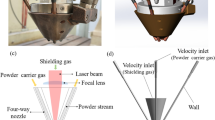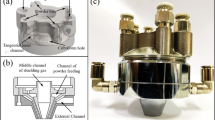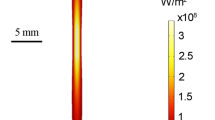Abstract
The powder transport characteristics and flow field structure can significantly affect the quality of laser direct metal deposition (LDMD), which are in relation to nozzle structure and powder feeding parameters. Numerical simulation based on the gas-solid two-phase theory is the most effective way to study those. In this work, a double-ring coaxial nozzle was developed, and a 3D numerical model of this nozzle considering particle collision was established to obtain particle space trajectory and powder jet structure. Combining with experiments, the aerodynamics of the nozzle, the transport phenomenon, flow field, and deposition forming of powder particles in the LDMD were studied. Moreover, their internal relation was discussed. Results show that the developed nozzle could transport powder well and prepare excellent deposited layers. The numerical model can accurately predict the structure and transport characteristics of powder jet flow. The powder jet flow is easier to converge, and the focus moves up due to the collision. With the increase of powder feeding rate, the powder jet flow becomes divergent, and the focal points are separated so that the axial concentration distribution presents a “double-peak” characteristic, which is beneficial to reduce the laser attenuation rate on the transmission channel and to ensure the formation of the molten pool by the substrate. The appropriate size of the deposited layer can be obtained at the powder-carrying gas flow rate of 4 L/min and the powder feeding rate of 2.0–3.6 g/min, with the powder utilization ratio up to 54.2% and the microstructure being uniform and dense, meeting the requirement of industrial application.













Similar content being viewed by others
References
Lu JZ, Cao J, Lu HF, Zhang LY, Luo KY (2019) Wear properties and microstructural analyses of Fe-based coatings with various WC contents on H13 die steel by laser cladding. Surf Coat Technol 369:228–237. https://doi.org/10.1016/j.surfcoat.2019.04.063
Yang N (2009) Concentration model based on movement model of powder flow in coaxial laser cladding. Opt Laser Technol 41:94–98. https://doi.org/10.1016/j.optlastec.2008.03.008
Ortiz A, García A, Cadenas M, Fernández MR, Cuetosc JM (2007) WC particles distribution model in the cross-section of laser cladded NiCrBSi + WC coatings, for different wt% WC. Surf Coat Technol 324:298–306. https://doi.org/10.1016/j.surfcoat.2017.05.086
Zhun GX, Li DC, Zhang AF, Tang YP (2011) Numerical simulation of metallic powder flow in a coaxial nozzle in laser direct metal deposition. Opt Laser Technol 43:106–113. https://doi.org/10.1016/j.optlastec.2010.05.012
Kovalev OB, Zaitsev AV, Novichenko D, Smurov I (2011) Theoretical and experimental investigation of gas flows, powder transport and heating in coaxial laser direct metal deposition (DMD) process. J Therm Spray Technol 20:465–478. https://doi.org/10.1007/s11666-010-9539-3
He B, Li DC, Zhang AF, Ge JB, Do XT, Xie H, Yang HT (2013) Influence of powder flow on sidewall quality of solid parts in laser metal direct forming. Int J Adv Manuf Technol 68:2703–2711. https://doi.org/10.1007/s00170-013-4805-4
Tan H, Zhang FY, Fu X, Meng J, Hu G, Fan W (2016) Development of powder flow model of laser solid forming by analysis method. Int J Adv Manuf Technol 82:1421–1431. https://doi.org/10.1007/s00170-015-7481-8
Kovalev OB, Kovaleva IO, Smurov IY (2017) Numerical investigation of gas-disperse jet flows created by coaxial nozzles during the laser direct material deposition. J Mater Process Technol 249:118–127. https://doi.org/10.1016/j.jmatprotec.2017.05.041
Lester S, Longfield N, Griffiths J, Cocker J, Staudenmaier, Broadhead G (2013) New systems for laser cladding: laser surface modifications in steel industry. Laser Technik J 10:41–43. https://doi.org/10.1002/latj.201390037
Lin J (2000) Numerical simulation of the focused powder streams in coaxial laser cladding. J Mater Process Technol 105:17–23. https://doi.org/10.1016/S0924-0136(00)00584-7
Pinkerton AJ, Li L (2004) Modelling powder concentration distribution from a coaxial deposition nozzle for laser-based rapid tooling. J Manuf Sci E-T ASME 126(1):33–41. https://doi.org/10.1115/1.1643748
Pinkerton AJ (2007) An analytical model of beam attenuation and powder heating during coaxial laser direct metal deposition. J Phys D Appl Phys 40:7323–7334. https://doi.org/10.1088/0022-3727/40/23/012
Liu JC, Li LJ (2005) Effects of powder concentration distribution on fabrication of thin-wall parts in coaxial laser cladding. Opt Laser Technol 37:287–292. https://doi.org/10.1016/j.optlastec.2004.04.009
Pan H, Sparks T, Thakar YD, Liou F (2006) The investigation of gravity-driven metal powder flow in coaxial nozzle for laser-aided direct metal deposition process. J Manuf Sci E-T ASME 128:541–553. https://doi.org/10.1115/1.2162588
Tabernero I, Lamikiz A, Ukar E, Lacalle LN, Angulo C, Urbikain G (2010) Numerical simulation and experimental validation of powder flux distribution in coaxial laser cladding. J Mater Process Technol 210:2125–2134. https://doi.org/10.1016/j.jmatprotec.2010.07.036
Liu H, Hao JB, Yu G, Yu G, Yang HF (2016) A numerical study on metallic powder flow in coaxial laser cladding. J Appl Fluid Mech 9(5):2247–2256. https://doi.org/10.18869/acadpub.jafm.68.236.25632
Liu H, He XL, Yu G, Wang ZB, Li SX, Zheng CY, Ning WJ (2015) Numerical simulation of powder transport behavior in laser cladding with coaxial powder feeding. Sci China Phys Mech Astron 58:104701. https://doi.org/10.1007/s11433-015-5705-4
Bedenko DV, Kovalev OB, Smurov I, Zaitsev AV (2016) Numerical simulation of transport phenomena, formation the bead and thermal behavior in application to industrial DMD technology. Int J Heat Mass Transf 95:902–912. https://doi.org/10.1016/j.ijheatmasstransfer.2015.12.046
Zhang J, Yang L, Zhang W, Qiu JB, Xiao HB, Yang L (2020) Numerical simulation and experimental study for aerodynamic characteristics and powder transport behavior of novel nozzle. Opt Lasers Eng 126:105873. https://doi.org/10.1016/j.optlaseng.2019.105873
Bedenko DV, Kovalev OB (2013) Modelling of heat and mass transfer in the laser cladding during direct metal deposition. Thermophys Aeromech 20(2):251–261. https://doi.org/10.1134/S086986431302011X
Liu JC, Li LJ, Zhang YZ, Xie XZ (2005) Attenuation of laser power of a focused Gaussian beam during interaction between a laser and powder in coaxial laser cladding. J Phys D Appl Phys 38(10):1546–1550. https://doi.org/10.1088/0022-3727/38/10/008
Cheikh EH, Courant B, Branchu S, Hascoȅt JY, Guillén R (2012) Analysis and prediction of single laser tracks geometrical characteristics in coaxial laser cladding process. Opt Lasers Eng 50:413–422. https://doi.org/10.1016/j.optlaseng.2011.10.014
Kovalev OB, Bedenko DV, Zaitsev AV (2017) Development and application of laser cladding modeling technique: from coaxial powder feeding to surface deposition and bead formation. Appl Math Model 57:339–359. https://doi.org/10.1016/j.apm.2017.09.043
Funding
This work was financially supported by the Natural Science Foundation of Zhejiang Province (Grant No. LY20E050026); the China Postdoctoral Science Foundation (Grant No. 2020 M672016); Natural Science Foundation of China (Grant No. 61805179); and Science and Technology Project of Wenzhou City (Grant No. G20190011).
Author information
Authors and Affiliations
Contributions
Jian Zhang: Formal analysis, Investigation, Writing-review and editing. Lin Yang: Formal analysis. Zhuoyuan Li: Data curation, Visualization. Qingmao Zhang: Methodology. Manjiang Yu: Conceptualization, Investigation. Chaolong Fang: Resources. Haibing Xiao: Resources.
Corresponding author
Ethics declarations
Ethics approval
The article follows the guidelines of the Committee on Publication Ethics (COPE) and involves no studies on human or animal subjects.
Consent to participate
Not applicable. The article involves no studies on humans.
Consent for publication
Not applicable. The article involves no studies on humans.
Competing interests
The authors declare no competing interests.
Additional information
Publisher’s note
Springer Nature remains neutral with regard to jurisdictional claims in published maps and institutional affiliations.
Rights and permissions
About this article
Cite this article
Zhang, J., Yang, L., Li, Z. et al. Transport phenomenon, flow field, and deposition forming of metal powder in the laser direct deposition with designed nozzle. Int J Adv Manuf Technol 114, 1373–1383 (2021). https://doi.org/10.1007/s00170-021-06913-x
Received:
Accepted:
Published:
Issue Date:
DOI: https://doi.org/10.1007/s00170-021-06913-x




